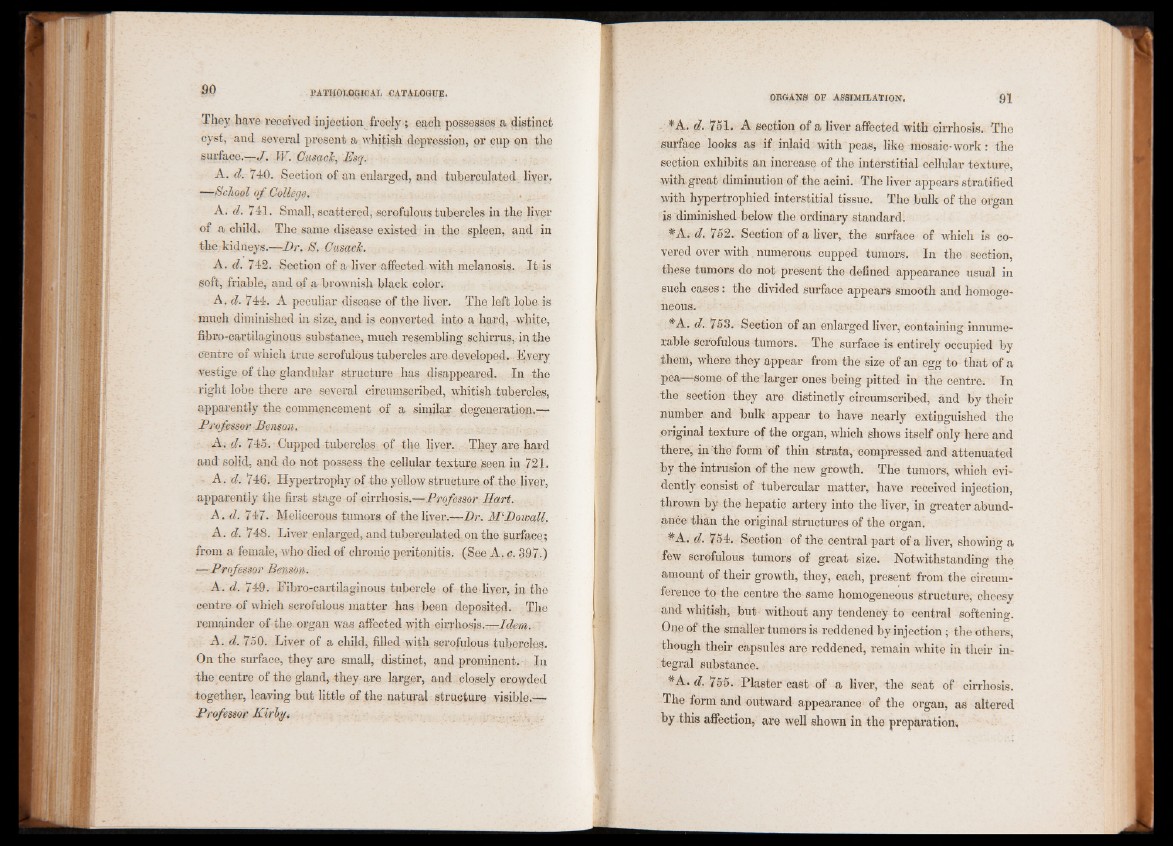
They have received injection freely; each possesses & distinct
cyst, and several present a whitish depression, or cup on the
surface.—/. W. Cusack, Esq.
A. d. 740. Section of an enlarged, and tuberculated liyer.
—School of College.
A. d. 741. Small, scattered, scrofulous tubercles in the liver
of a child. The same disease existed in the spleen, and in
the kidneys.—Dr. S. Cusack.
A. d. 742. ^Section of a liver affected with melanosis. It is
soft, friable, and pf a brownish black color.
A.d. 744. A peculiar disease of the liver. The left lobe, is
much diminished in size, and is converted into a hard, -white,
fibro-cartilaginous substance, much resembling schirrus, in the
centre of which true scrofulous tubercles are. developed. Every
vestige of the glandular structure lias disappeared. In the
right lobe there are several circumscribed, whitish tubercles,
apparently the commencement of a similar degeneration.—
Professor Benson,
A. d. 745. Cupped tubercles of the ljver., They are hard
and'solid, and do not possess the cellular texture seen in 721,
A. d. 746. Hypertrophy of the yellow structure, of the liver,
apparently the first stage of cirrhosis.—Professor Bart.
A. d. 747. Melicerous tumors of the liver.—Dr. MlDowall.
A . d. 748. Liver enlarged, and tuberculated on the surface;
from a female, who died of chronic peritonitis. (See A. c. 397.)
i—Professor Benson.
A. d. 749. Fibro-cartilaginous tubercle of the liver, in the
centre of which scrofulous matter has been deposited. The
remainder of the organ was affected with cirrhosis.-—Idem.
A. d.'loft. Liver of a child, filled with scrofulous tubercles.
On the surface, they are small, distinct, and prominent. In
the centre of the gland, they are larger, and closely crowded
together, leaving but little of the natural structure visible.—
Professor Kirby.
*A. d. 751. A section of a liver affected with cirrhosis. The
surface looks as if inlaid with peas, like mosaic-work: the
section exhibits an increase of the interstitial cellular texture,
with great diminution of the acini. The liver appears stratified
with hypertrophied interstitial tissue. The bulk of the organ
is diminished below the ordinary standard.
* A. d. 752. Section of a liver, the surface of which is covered
over with numerous cupped tumors. In the section,
these tumors do not present the defined appearance usual in
such cases: the divided surface appears smooth and homogeneous.
*A. d. 753. Section of an enlarged liver, containing innumerable
scrofulous tumors. The surface is entirely occupied by
them, where they appear from the size of an egg to that of a
P°a—some of the larger ones being pitted in the centre; In
the section they are distinctly circumscribed, and by their
number and bulk appear to have nearly extinguished the
original texture of the organ, which shows itself only here and
there, in the form of thin strata, compressed and attenuated
by the intrusion of the new growth. The tumors, which evidently
consist of tubercular matter, have received injection,
thrown by the hepatic artery into the liver, in greater abundance
than the original structures of the organ.
*A. d. 754. Section of the central part of a liver, showing a
few scrofulous tumors of great size. Notwithstanding the
amount of their growth, they, each, present from the circumference
to the centre the same homogeneous structure, cheesy
and whitish, but without any tendency to central softening.
One of the smaller tumors is reddened by injection; the others,
though their capsules are reddened, remain white in their integral
substance.
*A. d. 755. Plaster cast of a liver, the seat of cirrhosis.
The form and outward appearance of the organ, as altered
by this affection, are well shown in the preparation,